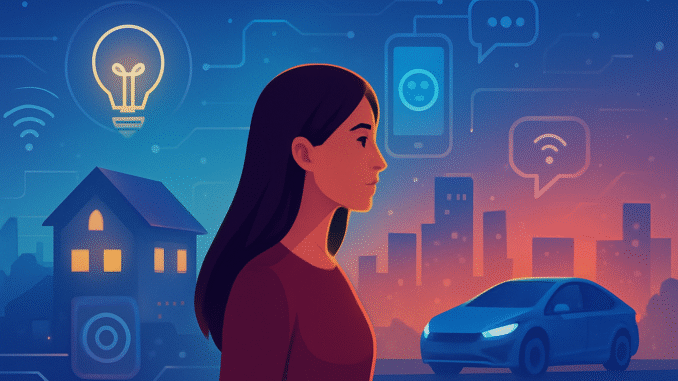
How Smart Technology Is Transforming Everyday Life in 2025 and Beyond
Technology has become more than just a convenience — it’s now a vital part of how we live, work, and connect. In 2025, the rise of smart technology has made daily life faster, easier, and more efficient than ever before. From homes that adjust automatically to your preferences, to health devices that monitor your body in real time, smart innovations are transforming the world around us.
Let’s explore how smart technology is reshaping everyday life in 2025 — and what we can expect in the years ahead.
1. Smart Homes: The Heart of Modern Living
In 2025, smart homes have evolved into intelligent ecosystems that understand and respond to human behavior.
Home automation systems now control lighting, temperature, entertainment, and even cooking. For example, voice assistants like Alexa, Google Assistant, and Apple HomePod can manage nearly every aspect of your home.
Imagine waking up to your curtains opening automatically, your coffee brewing, and your favorite morning playlist playing softly — all without lifting a finger. Smart refrigerators can now track what you eat, suggest recipes, and even order groceries automatically when supplies run low.
Security has also improved significantly with AI-powered cameras and motion sensors that learn to recognize familiar faces and detect unusual activity instantly. The result? A home that’s not only comfortable but also safe, energy-efficient, and intuitive.
2. Health and Fitness: Personalized Wellness Through Technology
Smart technology has revolutionized healthcare and wellness. In 2025, wearable devices and health apps go far beyond counting steps or tracking heart rates — they now monitor oxygen levels, sleep quality, stress levels, and even detect early signs of illness.
Smartwatches and fitness trackers provide real-time health data to users and doctors alike. Some advanced devices can even perform ECGs, check blood sugar levels, or alert emergency services if they detect abnormalities.
AI-driven telemedicine platforms also allow doctors to analyze data remotely, making healthcare more accessible and proactive.
This shift toward preventive care means that health problems can be detected early, reducing medical costs and improving quality of life. In short, smart technology is empowering people to take charge of their own health like never before.
3. Smarter Transportation: Mobility Made Effortless
Transportation has always been one of the most visible indicators of technological progress. In 2025, smart transportation systems are redefining how we move from place to place.
Self-driving cars, powered by AI and machine learning, are now more reliable and widely available. They communicate with traffic systems to avoid congestion, predict accidents, and ensure smoother rides. Electric vehicles (EVs) are now the norm, supported by an expanding network of smart charging stations.
Public transportation is also becoming more efficient. AI-powered apps provide real-time updates on bus and train schedules, while predictive analytics help city planners manage traffic flow and reduce emissions.
Even drones are joining the movement — delivering packages, medical supplies, and groceries directly to your doorstep. By integrating automation and AI, smart transportation is making travel safer, faster, and greener.
4. Smart Cities: Technology Meets Sustainability
Smart technology isn’t just transforming individual homes — it’s reshaping entire cities. In 2025, smart cities are becoming the blueprint for sustainable urban living.
These cities use interconnected systems to manage utilities, waste, energy, and traffic. Smart grids balance electricity usage, reducing energy waste and promoting renewable sources.
Streetlights automatically adjust brightness based on activity levels, and waste management systems alert collectors when bins are full. In some cities, IoT-based sensors monitor air and water quality, helping governments take real-time environmental action.
Citizens benefit from faster services, improved safety, and cleaner surroundings. Smart city technology is proving that digital innovation can lead to a more sustainable and livable future for everyone.
5. Education: Smarter Classrooms and Personalized Learning
The education sector has undergone a massive transformation thanks to smart technology. In 2025, AI-driven education and smart classrooms make learning more interactive and tailored to each student’s needs.
Virtual Reality (VR) and Augmented Reality (AR) tools allow students to explore complex subjects in immersive ways — from walking through ancient civilizations to conducting scientific experiments in a virtual lab.
AI tutors help identify learning gaps and provide personalized feedback, ensuring that every student progresses at their own pace. Smartboards and digital platforms enable teachers to track attendance, performance, and engagement in real time.
Online education has also become more interactive and collaborative, connecting students from around the world. With smart education tools, learning is no longer confined to the classroom — it’s accessible anytime, anywhere.
6. The Workplace of the Future: Smarter, Faster, and More Connected
Smart technology has redefined the modern workplace. In 2025, AI-powered systems, automation, and the Internet of Things (IoT) are helping businesses operate more efficiently than ever.
Smart offices use sensors to manage lighting, air conditioning, and space usage based on employee presence. Virtual collaboration tools — powered by AI and VR — make remote meetings more immersive and productive.
Automation handles repetitive tasks, freeing employees to focus on creativity, strategy, and innovation. AI assistants help with scheduling, communication, and data analysis, turning workplaces into hubs of intelligent productivity.
Hybrid work models have become the norm, supported by secure cloud systems and smart devices that allow seamless transitions between home and office environments.
7. Shopping and Retail: The Rise of Smart Commerce
In 2025, smart retail technology is transforming how consumers shop. Physical stores and online platforms are now deeply integrated, offering a seamless “phygital” (physical + digital) experience.
AI-powered recommendation systems personalize product suggestions based on preferences, purchase history, and even mood. Smart mirrors in fashion stores allow customers to try on clothes virtually, while AR apps let you visualize furniture in your home before buying.
Contactless payments, digital wallets, and blockchain-based transactions have made shopping faster and more secure. Even delivery systems have become smarter, with AI predicting demand and optimizing routes.
The result is a highly efficient and personalized shopping experience — one that blends convenience with innovation.
8. Entertainment and Media: Immersive and Interactive Experiences
The entertainment industry has been one of the biggest beneficiaries of smart technology. In 2025, AI and immersive media are redefining how we consume content.
Streaming services use smart algorithms to recommend shows based on your mood and viewing patterns. AR and VR technologies bring movies, concerts, and games to life in immersive environments.
Smart TVs, voice-controlled sound systems, and home theaters have made personalized entertainment a reality. Even social media is evolving with AI filters, augmented experiences, and real-time translations that connect people across cultures.
With 5G networks enabling ultra-fast connections, entertainment is no longer limited by screens — it’s becoming an interactive experience that engages all the senses.
9. The Role of Artificial Intelligence in Daily Life
Artificial Intelligence is the invisible force behind much of the smart technology we use today. In 2025, AI has become an everyday companion — understanding speech, predicting behavior, and assisting with decision-making.
From suggesting the fastest route to work to curating personalized playlists, AI is woven into every aspect of modern life. Smart devices now learn from user habits and adapt to improve comfort and efficiency.
Even personal finance is smarter — AI apps help users manage budgets, track spending, and make investment decisions. In essence, AI has become a silent partner that makes everyday living smoother and more intelligent.
10. The Future: Connected, Intelligent, and Sustainable
Looking beyond 2025, the future of smart technology holds even greater promise. With advancements in 6G connectivity, quantum computing, and green technology, the digital world is set to become faster, safer, and more sustainable.
Devices will continue to learn, evolve, and anticipate human needs with unprecedented accuracy. Automation and AI will handle complex tasks effortlessly, freeing people to focus on creativity, relationships, and well-being.
However, with these advancements come challenges — including data privacy, cybersecurity, and digital dependency. Balancing innovation with ethics will be key to ensuring technology serves humanity rather than controlling it.
The ultimate goal is not just smarter devices — but a smarter, more connected world that enhances quality of life for all.
Final Thoughts
In 2025, smart technology is no longer a futuristic dream — it’s a daily reality transforming how we live, learn, work, and connect. From homes and health to transportation and entertainment, these innovations are improving convenience, efficiency, and sustainability.
As we move forward, embracing these technologies responsibly will allow us to build a world where intelligence, connectivity, and humanity coexist in harmony. The future isn’t just digital — it’s smart, sustainable, and full of possibilities.
